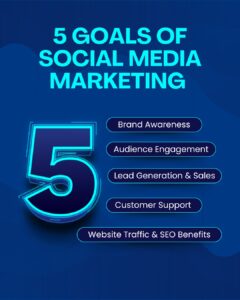Instagram and social media marketing have become essential tools for businesses trying to reach and engage modern audiences. With billions of users across platforms and millions active daily on Instagram alone, building a marketing strategy that incorporates both can help a business increase visibility, improve customer relationships, and drive measurable results.
Understanding how Instagram fits into the broader landscape of social media marketing is key to creating campaigns that resonate. In this article, we explore the role of Instagram within a full social strategy, providing insights, tips, and content examples suitable for beginners and seasoned marketers.
What Is Instagram and Social Media Marketing?
Instagram and social media marketing refer to the methods businesses use to promote their brand, products, or services through Instagram and other platforms like Facebook, Twitter, LinkedIn, and TikTok. Instagram marketing focuses on visual storytelling through posts, Reels, Stories, and ads, while broader social media strategies might involve text posts, blogs, video content, and interactive campaigns across multiple platforms.

Key Elements of Instagram and Social Media Marketing
- Content planning: Defining content themes, formats, and post schedules.
- Audience research: Understanding what content your target audience wants to see.
- Engagement: Replying to comments, liking content, and starting conversations.
- Analytics: Monitoring post reach, engagement rates, follower growth, and more.
Why Instagram Is Vital for Social Media Marketing
Instagram’s design supports photo and video-based storytelling. With high engagement rates and features like Stories, Reels, Live, and Shopping, it offers tools that help businesses increase visibility and reach their audiences in a visual and engaging format.
Benefits of Instagram and Social Media Marketing
- Increases brand awareness
- Helps humanize a brand
- Drives traffic to websites and product pages
- Encourages customer interaction
- Builds loyal communities around products and services
Getting Started with Instagram and Social Media Marketing
Step 1: Set Clear Goals
Decide what you want to achieve with Instagram and social media marketing. Common goals include:
- Increasing website traffic
- Growing brand awareness
- Generating leads or sales
- Improving customer service
Step 2: Identify Your Target Audience
Research who your ideal followers are. Consider factors such as:
- Age
- Gender
- Location
- Interests
- Online behavior
Step 3: Create a Content Strategy
Focus your Instagram and social media marketing efforts around content pillars. These can include:
- Educational content
- Behind-the-scenes posts
- Product demos
- Testimonials
- Seasonal promotions
Step 4: Build a Posting Schedule
A consistent posting schedule helps build follower trust. Use scheduling tools to plan weekly or monthly content calendars. Your Instagram and social media marketing should reflect current trends and major events.
Step 5: Track Performance
Review analytics on each platform. Track metrics like:
- Engagement (likes, shares, comments)
- Follower growth
- Website clicks
- Story views and reach
Instagram-Specific Marketing Tactics
Instagram is unique in how it allows businesses to build communities visually. Consider these key strategies:
Optimize Your Profile
- Use a professional username
- Write a clear, keyword-focused bio
- Add a link to your website or landing page
Use Hashtags Wisely
Hashtags increase post discoverability. Combine niche and broad hashtags in your Instagram and social media marketing efforts.
Leverage Stories and Highlights
Stories can showcase behind-the-scenes content, announcements, or time-sensitive promotions. Highlights help extend the life of your best Stories.
Use Reels for Reach
Reels attract new followers. Focus on short, engaging videos related to your niche. Trends can help boost views.
Collaborate with Influencers
Influencer marketing is effective when done with the right partners. Choose individuals whose values align with your brand.
Cross-Platform Social Media Marketing Tips
Instagram and social media marketing go hand-in-hand with cross-platform strategies. To stay efficient:
Repurpose Content
Turn one Instagram post into:
- A Facebook update
- A Pinterest pin
- A YouTube Short
- A Twitter thread
Maintain Brand Voice
Stay consistent in tone across platforms. Whether professional, casual, or friendly, your audience should feel familiarity in every post.
Engage in Real-Time
Reply to comments quickly. Monitor mentions and tags. Use live sessions to boost interaction.
Paid Advertising
Paid social ads can expand reach and drive conversions. Instagram Ads can target users by interest, behavior, and demographics. Use A/B testing to compare visuals and calls-to-action.
YouTube Video Description Examples for Beginners
If you’re creating YouTube content to support your Instagram and social media marketing, descriptions play an important role in helping people find and understand your content. Here are some beginner-friendly examples:
Example 1: “In this video, I’m sharing my top tips for Instagram and social media marketing. Learn how to grow your brand, build engagement, and plan content effectively. Don’t forget to like and subscribe!”
Example 2: “If you’re just starting out with Instagram and social media marketing, this guide is for you. Discover how to create engaging content, use hashtags, and schedule posts.”
Example 3: “Want better results from your social media? Learn Instagram and social media marketing basics in this easy-to-follow tutorial. Perfect for small businesses and creators.”
Common Challenges in Instagram and Social Media Marketing
Despite its potential, Instagram and social media marketing comes with its share of obstacles:
Algorithm Changes
Engagement might drop due to frequent platform updates. Stay current with changes and adapt your strategy.
Content Fatigue
Audiences may lose interest if content becomes repetitive. Refresh your posts and test new formats.
Managing Multiple Platforms
It can be overwhelming to post across channels. Use scheduling tools and keep content repurposable.
Best Tools for Instagram and Social Media Marketing
Use tools to make your workflow more efficient:
- Canva: For designing social graphics
- Buffer or Later: Scheduling posts
- Meta Business Suite: Managing Instagram and Facebook together
- Google Analytics: Measuring traffic from social platforms
- Hashtagify: Researching trending hashtags
FAQs about Instagram and Social Media Marketing
What is the difference between Instagram and other social media platforms?
Instagram focuses on visual content, especially photos and videos. Other platforms may be more text-based or suited for link sharing, like Twitter or LinkedIn.
How often should I post for Instagram and social media marketing?
Consistency is important. Aim for 3–5 Instagram posts per week and adjust based on performance.
Should I use the same content on Instagram and other platforms?
You can repurpose content, but adjust formats to fit each platform. Instagram favors visuals, while LinkedIn may benefit from articles and case studies.

What are the best times to post for Instagram and social media marketing?
Generally, late mornings to early afternoons on weekdays perform best. Review your analytics to find your audience’s active hours.
How do I measure success in Instagram and social media marketing?
Track metrics such as:
- Engagement rate
- Follower growth
- Click-throughs to your site
- Conversion rates
Conclusion
Instagram and social media marketing continue to play a vital role in how brands communicate with audiences. By understanding platform strengths, staying consistent, and creating thoughtful content strategies, businesses can use Instagram and broader social networks to connect meaningfully with their target audience. Whether you’re just getting started or refining your current efforts, apply these strategies and tips to create an effective, measurable plan for Instagram and social media marketing.
